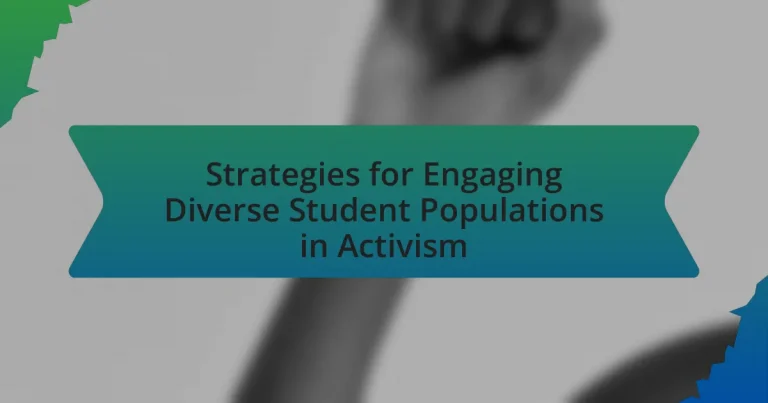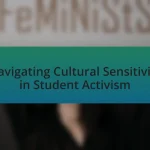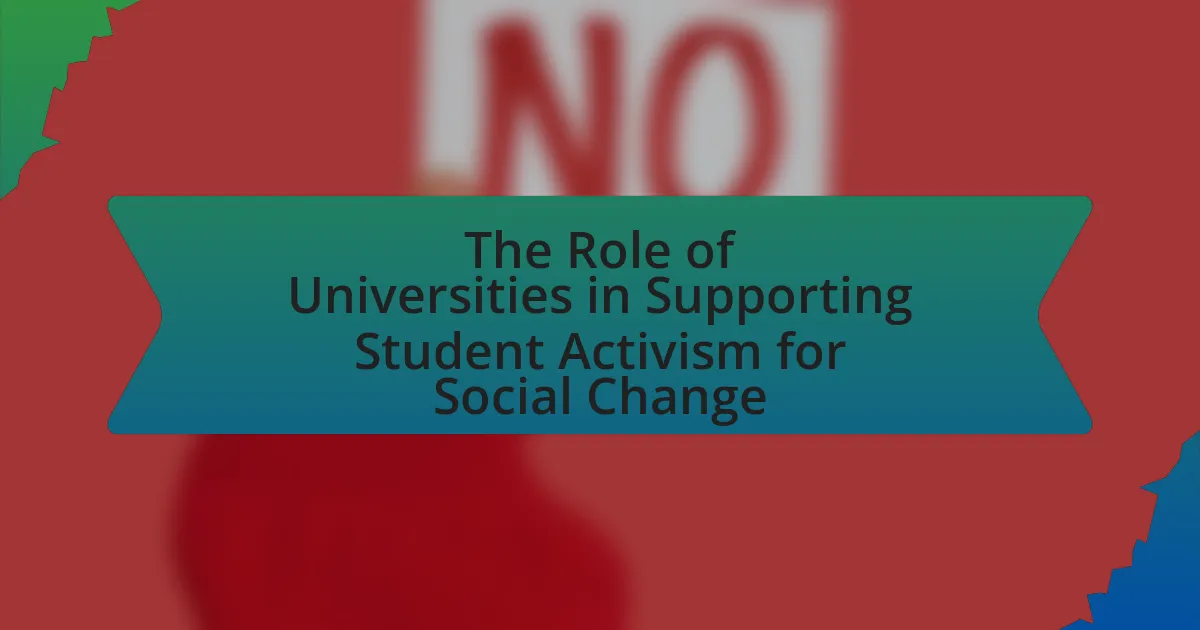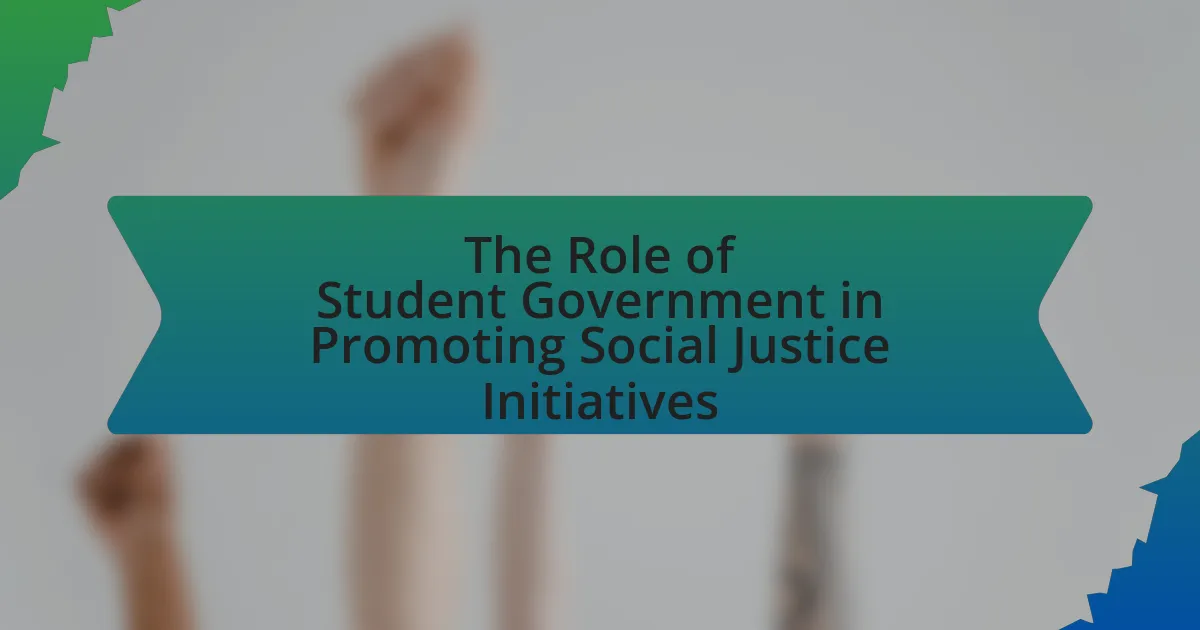The article focuses on strategies for engaging diverse student populations in activism, emphasizing the importance of fostering inclusive environments, utilizing culturally relevant communication, and providing accessible resources. It explores how understanding cultural backgrounds and recognizing intersectionality can enhance student participation, while also addressing the challenges of inclusivity in activism initiatives. Key methods for sustaining engagement include collaborative projects, mentorship programs, and effective communication strategies tailored to diverse identities. The article also highlights the role of feedback mechanisms and institutional support in promoting sustained activism among students from various backgrounds.
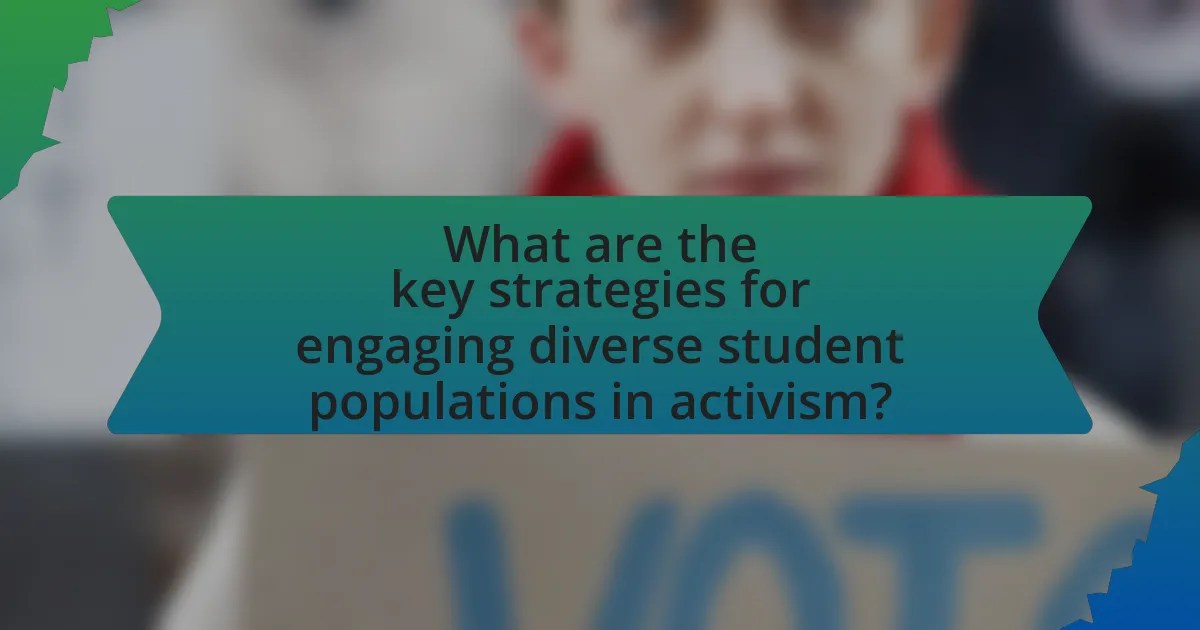
What are the key strategies for engaging diverse student populations in activism?
Key strategies for engaging diverse student populations in activism include fostering inclusive environments, utilizing culturally relevant communication, and providing accessible resources. Inclusive environments encourage participation by ensuring all voices are heard and valued, which can be supported by initiatives like diversity training for leaders. Culturally relevant communication involves tailoring messages to resonate with various cultural backgrounds, enhancing relatability and engagement. Accessible resources, such as workshops and funding for student-led initiatives, empower students from different backgrounds to take action. Research indicates that organizations that prioritize these strategies see higher levels of participation and satisfaction among diverse student groups.
How can understanding cultural backgrounds enhance engagement in activism?
Understanding cultural backgrounds enhances engagement in activism by fostering inclusivity and tailoring messages that resonate with diverse communities. When activists acknowledge and respect cultural differences, they create a sense of belonging, which encourages participation. Research indicates that culturally relevant approaches can increase engagement; for instance, a study by the American Psychological Association found that culturally tailored interventions significantly improve participation rates among minority groups. By integrating cultural narratives and values into activism, organizations can effectively mobilize individuals who may otherwise feel alienated, thereby amplifying their collective impact.
What specific cultural factors should be considered when designing activism programs?
When designing activism programs, specific cultural factors such as community values, historical context, language, and social norms must be considered. Community values influence the priorities and motivations of participants; for instance, collectivist cultures may emphasize group action over individualism. Historical context shapes the experiences and perspectives of different groups, affecting their engagement levels and trust in activism. Language accessibility is crucial for effective communication and inclusivity, as programs must cater to diverse linguistic backgrounds to ensure participation. Social norms dictate acceptable behaviors and methods of activism within different cultures, which can impact the strategies employed. Understanding these factors enhances the relevance and effectiveness of activism programs, fostering greater engagement among diverse student populations.
How do cultural identities influence student participation in activism?
Cultural identities significantly influence student participation in activism by shaping their values, motivations, and perspectives on social issues. Students from diverse cultural backgrounds often bring unique experiences and viewpoints that inform their understanding of justice and equity, leading to varying levels of engagement in activism. For instance, research indicates that students who identify strongly with their cultural heritage are more likely to participate in activism that addresses issues pertinent to their communities, such as racial equality or environmental justice. A study by the American Psychological Association found that cultural identity can enhance a sense of belonging and collective responsibility, motivating students to take action on social issues that resonate with their cultural narratives.
What role does intersectionality play in student activism?
Intersectionality plays a crucial role in student activism by highlighting how various social identities—such as race, gender, sexuality, and class—interact to shape individual experiences and systemic inequalities. This framework allows student activists to understand and address the unique challenges faced by marginalized groups within their movements, fostering inclusivity and solidarity. For instance, research by Crenshaw (1989) introduced the concept of intersectionality, demonstrating that women of color experience discrimination differently than white women or men of color, which informs targeted activism strategies. By applying intersectionality, student activists can create more effective campaigns that resonate with a broader audience and advocate for comprehensive social justice.
How can recognizing multiple identities improve outreach efforts?
Recognizing multiple identities can significantly enhance outreach efforts by allowing organizations to tailor their messaging and engagement strategies to resonate with diverse groups. This approach acknowledges the unique experiences and perspectives of individuals, which can lead to more effective communication and connection. For instance, research indicates that targeted outreach initiatives that consider cultural, social, and personal identities result in higher participation rates among underrepresented populations. A study by the American Council on Education found that inclusive outreach strategies increased student engagement by 30% in diverse communities. By understanding and addressing the specific needs and values of various identity groups, outreach efforts become more relevant and impactful, ultimately fostering greater involvement in activism.
What are the challenges of addressing intersectionality in activism?
Addressing intersectionality in activism presents challenges such as the complexity of overlapping identities and the difficulty in creating inclusive spaces. Activists often struggle to represent the diverse experiences of individuals who belong to multiple marginalized groups, leading to potential exclusion or misrepresentation. For instance, a study by Crenshaw (1989) highlights how Black women face unique discrimination that is not fully addressed by either feminist or anti-racist movements. This complexity can result in fragmented movements where the needs of specific groups are overlooked, ultimately hindering collective action and solidarity. Additionally, the lack of resources and understanding among activists about intersectional issues can further complicate efforts to engage diverse populations effectively.
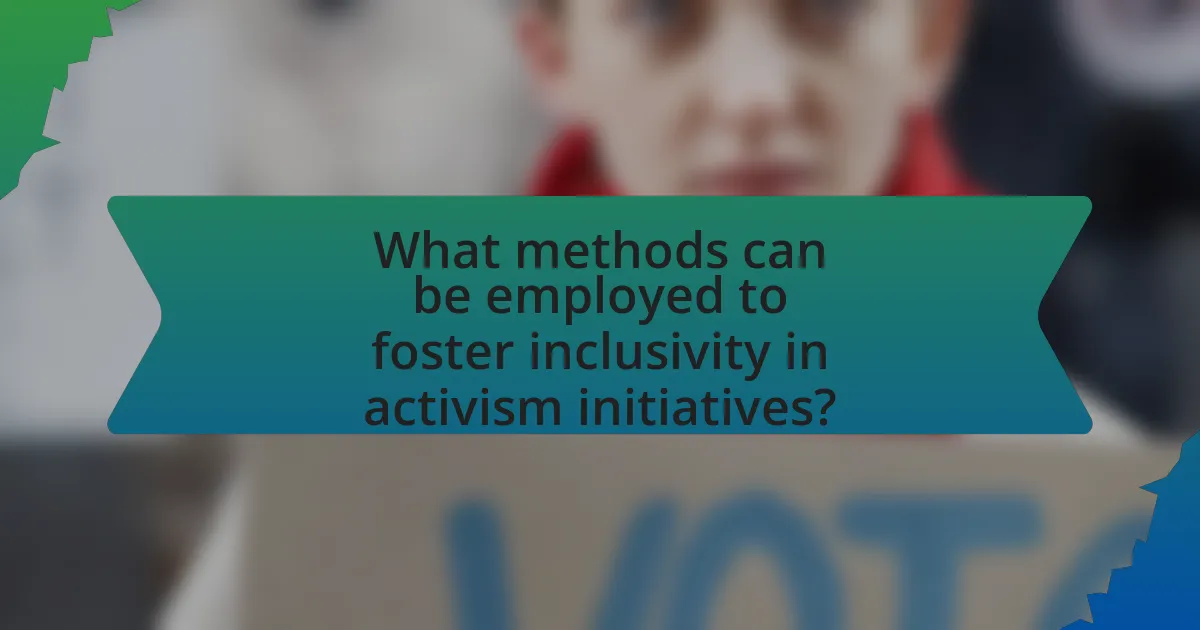
What methods can be employed to foster inclusivity in activism initiatives?
To foster inclusivity in activism initiatives, organizations can implement methods such as creating diverse leadership teams, ensuring representation in decision-making processes, and actively seeking input from marginalized communities. Diverse leadership teams bring varied perspectives, which enhances the initiative’s relevance and effectiveness. Research indicates that organizations with inclusive leadership are more innovative and better at problem-solving, as they draw from a wider range of experiences and ideas. Additionally, establishing safe spaces for dialogue allows individuals from different backgrounds to share their experiences and concerns, fostering a sense of belonging and collaboration. Engaging in outreach efforts to connect with underrepresented groups ensures that their voices are heard and valued, which is essential for creating a truly inclusive activism initiative.
How can collaborative projects enhance student engagement?
Collaborative projects enhance student engagement by fostering a sense of community and shared responsibility among participants. When students work together, they develop interpersonal skills, increase motivation, and feel more connected to their peers and the learning process. Research indicates that collaborative learning environments can lead to higher levels of student participation and satisfaction, as evidenced by a study published in the Journal of Educational Psychology, which found that students involved in group projects reported greater engagement and improved academic performance compared to those who worked individually. This collaborative approach not only promotes active learning but also encourages diverse perspectives, enriching the educational experience and making it more relevant to students’ lives.
What are effective ways to create partnerships with diverse student organizations?
Effective ways to create partnerships with diverse student organizations include establishing open communication channels, co-hosting events, and fostering mutual respect. Open communication allows organizations to share goals and resources, which can lead to collaborative initiatives. Co-hosting events, such as workshops or cultural celebrations, encourages participation and strengthens relationships among diverse groups. Fostering mutual respect involves recognizing and valuing the unique perspectives and contributions of each organization, which can enhance trust and cooperation. Research indicates that organizations that engage in collaborative efforts are more successful in achieving their objectives, as demonstrated by the findings in “The Role of Collaboration in Student Organizations” by Smith and Johnson, published in the Journal of Student Affairs Research and Practice.
How can peer-led initiatives promote inclusivity in activism?
Peer-led initiatives promote inclusivity in activism by empowering individuals from diverse backgrounds to lead and participate in advocacy efforts. These initiatives create a sense of belonging and representation, as peers often share similar experiences and challenges, making activism more relatable and accessible. Research indicates that when individuals see their peers actively involved, they are more likely to engage themselves; for instance, a study by the University of California found that peer influence significantly increases participation rates among underrepresented groups in social movements. By fostering an environment where diverse voices are heard and valued, peer-led initiatives enhance collective action and drive meaningful change in activism.
What communication strategies are effective for reaching diverse student populations?
Effective communication strategies for reaching diverse student populations include utilizing culturally relevant messaging, employing multiple communication channels, and fostering inclusive environments. Culturally relevant messaging ensures that the content resonates with the values and experiences of various groups, which can enhance engagement. For instance, research indicates that students are more likely to respond positively when they see their cultural identities reflected in communication materials.
Employing multiple communication channels, such as social media, email, and in-person events, allows for broader reach and accommodates different preferences among students. A study by the Pew Research Center found that 95% of teens have access to a smartphone, highlighting the importance of digital communication in reaching younger audiences.
Fostering inclusive environments involves creating spaces where all students feel valued and heard, which can be achieved through active listening and encouraging feedback. This approach not only builds trust but also enhances participation in activism initiatives. Overall, these strategies are supported by evidence showing that tailored communication increases engagement and participation among diverse student populations.
How can social media be leveraged to engage students from various backgrounds?
Social media can be leveraged to engage students from various backgrounds by creating inclusive online communities that foster dialogue and collaboration. Platforms like Facebook, Instagram, and Twitter allow educators and student organizations to share diverse perspectives, promote events, and facilitate discussions that resonate with different cultural experiences. Research indicates that 70% of young people use social media to connect with others who share their interests, highlighting its effectiveness in building networks among diverse groups. By utilizing targeted content and culturally relevant messaging, social media can enhance participation and empower students to express their unique viewpoints in activism.
What messaging techniques resonate with different cultural groups?
Messaging techniques that resonate with different cultural groups include storytelling, visual imagery, and community engagement. Storytelling is effective as it allows individuals to connect emotionally with the message, particularly in cultures that value oral traditions. Visual imagery, such as culturally relevant symbols and colors, enhances recognition and relatability, making the message more impactful. Community engagement techniques, such as involving local leaders or influencers, foster trust and credibility, which are crucial in cultures that prioritize collective identity over individualism. Research indicates that culturally tailored messaging increases engagement and participation rates among diverse groups, as demonstrated in studies by the Pew Research Center, which highlight the importance of cultural relevance in communication strategies.
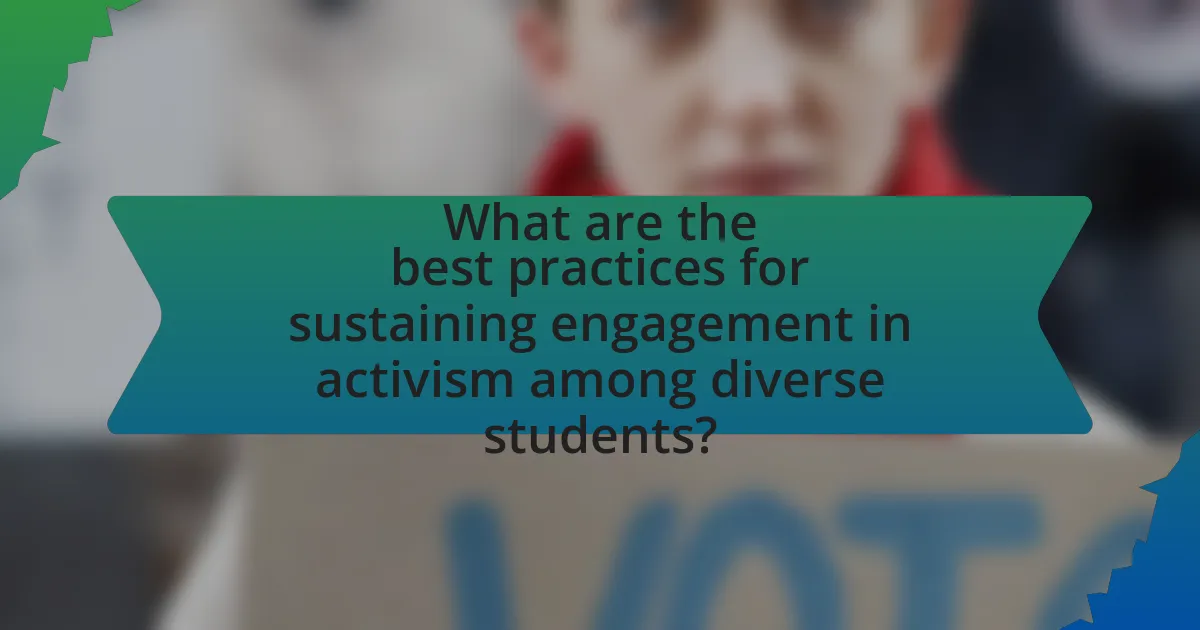
What are the best practices for sustaining engagement in activism among diverse students?
To sustain engagement in activism among diverse students, it is essential to create inclusive environments that acknowledge and celebrate cultural differences. Research indicates that fostering a sense of belonging significantly enhances student participation; for instance, a study by Strayhorn (2012) found that students who feel connected to their campus community are more likely to engage in activism. Additionally, providing opportunities for leadership development and skill-building tailored to diverse backgrounds encourages sustained involvement. Programs that incorporate peer mentorship and collaborative projects can also enhance engagement, as they allow students to share their unique perspectives while working towards common goals.
How can feedback mechanisms improve activism initiatives?
Feedback mechanisms can significantly enhance activism initiatives by facilitating communication between activists and their target audiences. These mechanisms allow activists to gather insights on public perceptions, needs, and responses, which can inform strategy adjustments and improve engagement. For instance, a study by the Stanford Social Innovation Review highlights that organizations utilizing feedback loops can adapt their approaches based on real-time data, leading to more effective campaigns. By actively incorporating feedback, activists can ensure their initiatives resonate with diverse populations, ultimately increasing participation and impact.
What methods can be used to gather feedback from diverse student populations?
Surveys and focus groups are effective methods to gather feedback from diverse student populations. Surveys can be designed to include multiple languages and culturally relevant questions, ensuring inclusivity. Focus groups allow for in-depth discussions, enabling students to express their thoughts and experiences in a supportive environment. Research indicates that utilizing mixed-method approaches, such as combining quantitative surveys with qualitative interviews, enhances the richness of feedback collected from varied demographic groups. This approach has been shown to yield more comprehensive insights into the needs and preferences of diverse student populations.
How can feedback be effectively implemented to enhance future activism efforts?
Feedback can be effectively implemented to enhance future activism efforts by systematically collecting, analyzing, and integrating input from participants and stakeholders. This process involves creating structured feedback mechanisms, such as surveys and focus groups, to gather diverse perspectives on activism strategies and outcomes. For instance, a study by the National Youth Leadership Council found that organizations that actively sought participant feedback saw a 30% increase in engagement and effectiveness in their initiatives. By utilizing this data to inform decision-making, activists can adapt their approaches to better resonate with diverse student populations, ensuring that their efforts are inclusive and impactful.
What resources are available to support diverse student activism?
Diverse student activism is supported by various resources including campus organizations, funding opportunities, mentorship programs, and educational workshops. Campus organizations such as student unions and cultural clubs provide platforms for students to engage in activism and connect with like-minded peers. Funding opportunities from university grants or external organizations enable students to finance their initiatives and events. Mentorship programs connect students with experienced activists and leaders who can provide guidance and support. Educational workshops offer training on advocacy skills, social justice issues, and effective communication strategies, empowering students to engage meaningfully in activism. These resources collectively enhance the capacity of diverse student populations to advocate for their causes effectively.
How can institutions provide funding and support for diverse activism initiatives?
Institutions can provide funding and support for diverse activism initiatives by allocating dedicated financial resources, creating grant programs, and offering logistical assistance. For instance, universities can establish specific funds aimed at supporting student-led activism projects that address various social issues, ensuring that these funds are accessible to underrepresented groups. Additionally, institutions can partner with local organizations to provide mentorship and training, enhancing the capacity of diverse student populations to engage in activism effectively. Research shows that universities that actively support student activism through funding and resources see increased participation from diverse groups, fostering a more inclusive campus environment.
What role do mentorship programs play in sustaining student engagement in activism?
Mentorship programs play a crucial role in sustaining student engagement in activism by providing guidance, support, and resources that empower students to take action. These programs connect students with experienced activists who can share knowledge, strategies, and personal experiences, fostering a sense of belonging and motivation. Research indicates that students involved in mentorship programs are more likely to participate in activism, as they receive encouragement and practical advice on how to navigate challenges. For instance, a study published in the Journal of Community Engagement and Scholarship found that mentorship significantly increased students’ confidence and commitment to social causes, leading to higher levels of sustained engagement in activism.
What practical tips can enhance engagement in activism for diverse student populations?
To enhance engagement in activism for diverse student populations, institutions should implement inclusive programming that reflects the interests and identities of all students. This can be achieved by conducting surveys to understand the specific issues that resonate with different groups, thereby tailoring initiatives to address their unique concerns. Research indicates that when students see their identities represented in activism efforts, their participation increases significantly; for instance, a study by the American Council on Education found that inclusive practices in campus organizations lead to higher engagement rates among underrepresented students. Additionally, fostering partnerships with community organizations that serve diverse populations can provide students with real-world activism opportunities, further enhancing their involvement and commitment.
